Energy-saving technologies cutting firms' fuel bills
- Published
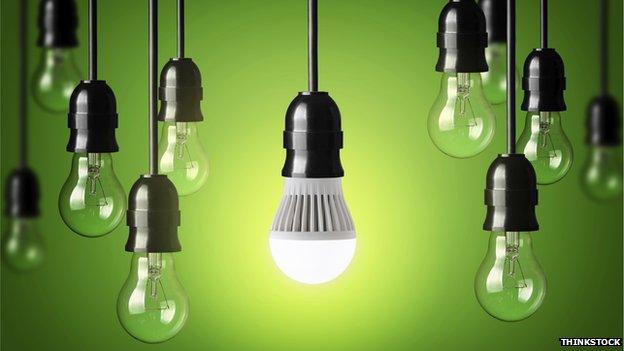
Electricity costs have doubled for businesses over the last decade, says energy saving body the Carbon Trust, pushing sustainability issues to the top of the agenda.
But these days "going green" is as much about business survival as reducing impact on the environment.
Yet surveys show many businesses still struggle to understand the technologies available and are wary about the upfront costs involved.
Technology of Business offers a guide to the most effective ways businesses can cut their energy bills and begin operating more sustainably.
LED lighting
Switching to LED - Light Emitting Diode - lighting is the quickest and simplest action any business can take to reduce energy usage, argues Myles McCarthy, director of implementation at the Carbon Trust.
A traditional 60 watt incandescent bulb would produce about 750 to 1,000 lumens - a measure of lighting power - but 95% of the energy used to create that light would typically be wasted in heat.
Modern LED lights are much more thermally efficient and can now produce between 50 and 100 lumens per watt (lm/W) in normal working conditions.
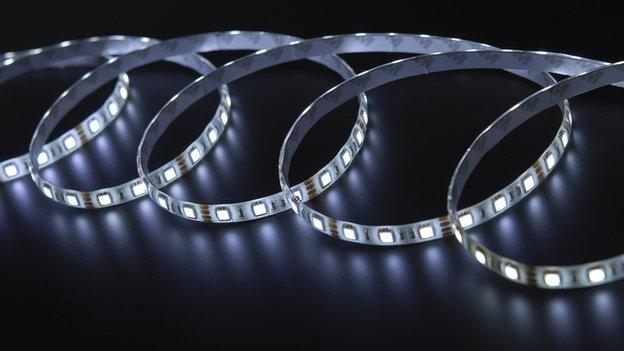
Switching to LED lighting is the simplest way for businesses to cut their energy bills
One US manufacturer, Cree, reckons it has produced a white light LED bulb that can produce 300 lm/W.
Mr McCarthy says payback on investment in LED is typically between one and three years. For example, one retail outlet client invested £74,000 in new lighting, resulting in a 74% lighting energy reduction and savings of around £33,000 per year, he says.
"This is why we've seen considerable investment in LED in recent years."
Smart monitoring
Smart meters, thermostats, and sensors - part of what's being called "the internet of things" - are giving us data about our energy consumption patterns that we never had before.
"It's the ability of these meters to communicate that's smart, not their ability to record energy usage," argues Joel Hagan, chief executive of smart metering company, Onzo.
"They give us far more visibility than we ever had before, down to the energy usage of individual appliances."
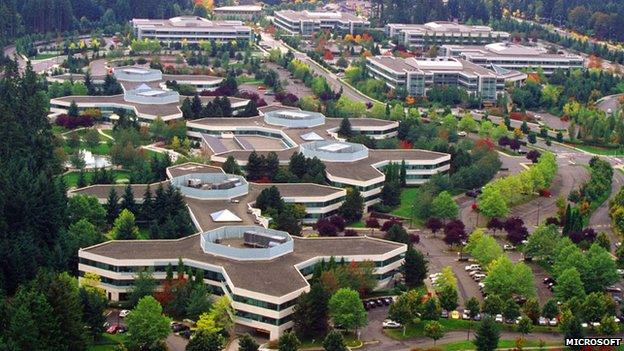
Applying "internet of things" data analytics to Microsoft's campus in Redmond, Washington could reduce energy usage by 10% a year, the company says, saving it "millions of dollars"
This increased visibility is helping businesses identify energy wastage more easily and make potentially huge savings.
Quentin Clark, head of Microsoft's data platform group, told the BBC: "By implementing internet of things control systems and big data analytics at our headquarters campus [in Redmond, Washington] we were able to spot aberrations in our energy usage, such as a garage that had air conditioning."
Microsoft says its 88 Acres project, involving 125 buildings, 30,000 pieces of equipment generating 500 million data transactions every day, could produce energy savings of up to 10% a year for the company, saving it "millions of dollars".

Walgreens' first "net zero energy" store just outside Chicago
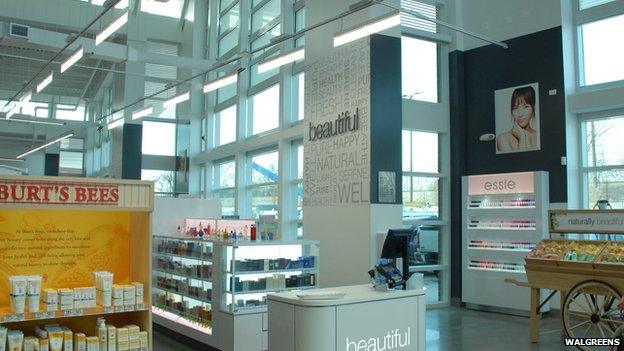
The store uses low-energy LED lighting controlled by an energy management system
In another example, Mike Franco, chief executive of California-based smart building systems firm, RiptideIO, says his company implemented a $20m [£12m; 14m euros] energy management system for US drugstore chain, Walgreens.
The project, which involved thousands of stores, saved the retailer $14m last year alone, he says.
Walgreens completed its first "net zero energy" store just outside Chicago late last year, incorporating solar photovoltaic (PV), LED lighting and wind turbines to produce more energy than it takes from the grid.
Up the junction
Any conglomeration of buildings can benefit from lighting and energy control systems, says Chris Bedford, managing director of intelligent lighting controls company, Open Technology.
A recent project at Clapham Junction railway station in London reduced lighting energy usage by 40%, he says.
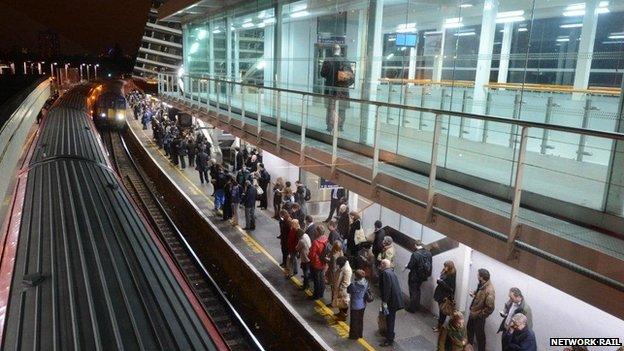
Control systems have cut lighting energy usage by 40% at London's Clapham Junction railway station
The initial investment of about £30,000 formed part of a wider energy reduction strategy to achieve total annual savings of over £7m for Network Rail and South West Trains.
Smaller energy control system projects can cost about £6,000 and above, depending on the size of the business, he added.
With savings like these on offer, it's no wonder Martin Chilcott, founder of sustainable business community 2degrees, says: "Our Trends Tracker survey shows that businesses consider smart metering and energy management software to be second only to LED lighting in importance."
Solar gain
Once a business has made efficiencies to its current equipment and energy usage patterns, generating its own electricity through renewable technology could be a sensible next step, experts advise.
The Energy Saving Trust's Greg Shreeve describes solar PV as a "sure-fire" investment for businesses with the necessary capital.
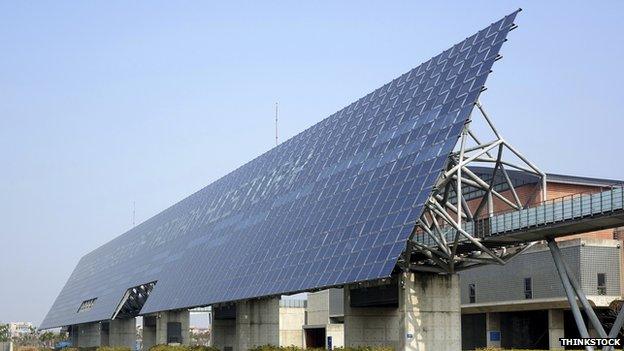
The National Museum of Taiwan History in Tainan features a giant wall of solar panels
The cost of installing PV panels has fallen dramatically over the last 10 years while their efficiency has improved, making them an obvious useful addition to business buildings big or small.
Not only can they help reduce your electricity bills but you'll get paid for the electricity you generate and export to the grid thanks to the UK's Feed-In Tariffs, external (FITs) scheme.
Introduced in April 2010, the scheme pays businesses for the electricity they generate through solar, wind turbines, hydro, anaerobic digesters or combined heat-and-power systems. The rate of generation subsidy - currently more than 14p per kilowatt hour for small schemes - is under review and could be reduced.
And how much support you receive also depends on your property's Energy Performance Certificate rating, so it makes sense to have improved your firm's energy efficiency before applying.
But with small-scale solar PV systems currently costing between £5,000 and £10,000, you could still see a return on investment within six to 10 years, installers say.
Electric fruit
Local delivery companies should consider switching their fleets to electric vehicles, advises Tim Anderson, senior transport manager at the Energy Saving Trust.
When Fruit4London, a small company delivering fresh fruit to city workers, invested in a fleet of four electric vans, "It was one of the best decisions we ever made," says co-founder Laszlo Mulato.
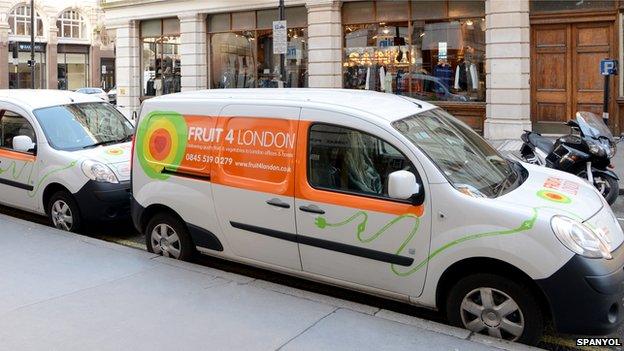
Fruit4London says switching to electric vans was "one of the best decisions we ever made".
A £5,000 government subsidy for electric vehicles reduced the cost of each Renault van to about £13,000 (plus VAT), says Mr Mulato. And each van saves the business £9,000 a year in congestion charge fees, maintenance and fuel costs, he adds.
"We haven't been able to increase our prices for five years, so savings like these help keep us competitive."
The company leases the vehicle battery from Renault for about £70 a month and it costs less than £1 a day to charge. With each van doing up to 60 miles a day, range is not an issue, he adds.
The switch to electric vehicles has had the added advantage of pleasing big clients who want their suppliers to be green as well, says Mr Mulato.